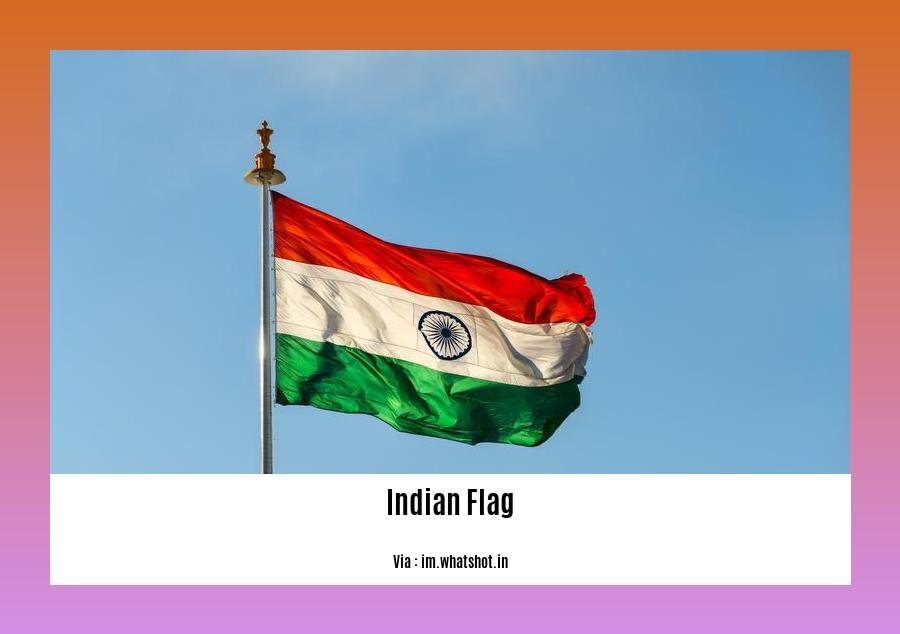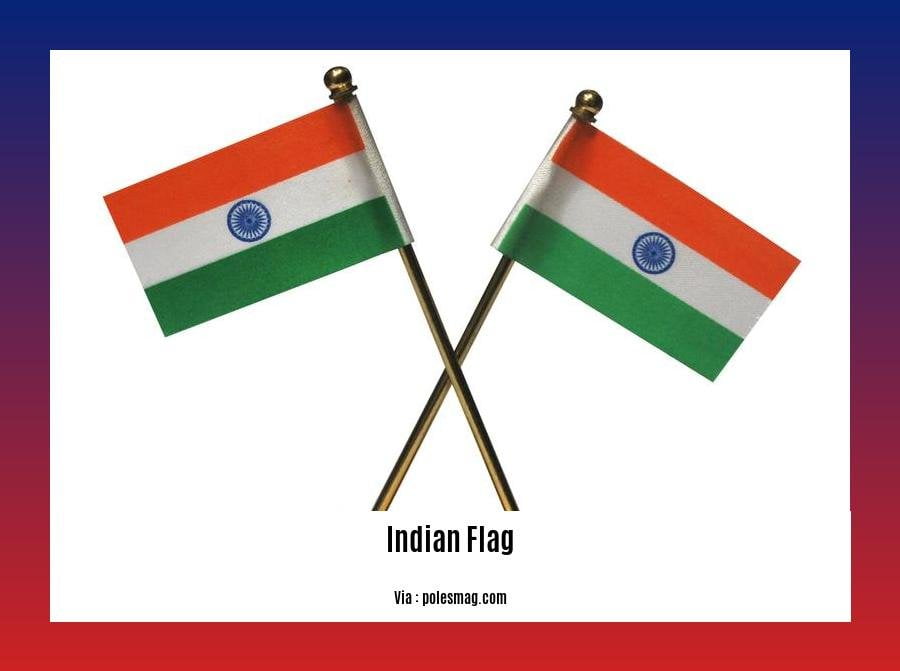Welcome to “Unveiling the Symbolic Essence: Exploring the Design, Meanings, and Historical Context of the Indian Flag,” where we embark on a fascinating journey to unravel the story behind one of the most iconic and revered symbols of India. As we delve into its design, meanings, and historical significance, prepare to be captivated by the rich tapestry of symbolism woven into the tricolor fabric that represents the aspirations, values, and struggles of a nation. From the profound symbolism of the colors to the historical context that shaped its creation, this article will unveil the deep-rooted essence of the Indian flag, inviting you to embark on a meaningful exploration of its enduring significance.
Key Takeaways:
- The Indian flag is a symbol of pride and elegance, with the colors saffron, white, and green representing courage, purity, and fertility respectively.
- The current form of the Indian flag was adopted on July 22, 1947, and was designed by Pingali Venkayya, a renowned freedom fighter.
- There are specific rules governing the flying of the Indian flag, including not allowing it to touch the ground, hoisting it at a particular height, and not using a damaged or soiled flag.
- Disrespecting the Indian flag is a punishable offense under Indian law.
- Pingali Venkayya made significant contributions to the Indian independence movement and is remembered for his role in designing the flag.
Unveiling the Symbolic Essence: Exploring the Design, Meanings, and Historical Context of the Indian Flag

The Indian flag, with its vibrant colors and intricate design, holds a deep significance in the hearts of Indians. It represents the rich history and diverse culture of the country, embodying the spirit of its people.
Evolution of the Flag
The journey of the Indian flag started during the freedom struggle, when various designs were proposed by different leaders. However, it was Pingali Venkayya, an Indian freedom fighter, who played a pivotal role in creating the design that we know today. On July 22, 1947, the current form of the flag was adopted, serving as a powerful symbol of India’s independence.
The Meaning Behind the Colors
Each color of the Indian flag carries its own unique symbolism, reflecting the values and aspirations of the nation. Saffron, a vibrant orange hue, represents courage and sacrifice. It serves as a reminder of the bravery and determination displayed by the Indian freedom fighters who fought for independence.
White, the color of purity and truth, signifies the unwavering commitment to truth and justice that India aspires to uphold. It serves as a reminder that the ideals of honesty and integrity should guide the nation’s actions.
Green, a color associated with nature and growth, represents fertility, growth, and auspiciousness. It symbolizes India’s rich agricultural heritage and the aspiration for progress and prosperity.
Rules of Respect
To ensure that the Indian flag is revered and accorded the respect it deserves, certain rules and guidelines govern its display and use. The flag should never touch the ground and should always be hoisted at a specific height. It is crucial to handle the flag with care and avoid using a damaged or soiled flag. These rules highlight the importance of treating the flag with utmost reverence and honor.
Pingali Venkayya: Patriot and Designer
Behind the design of the Indian flag stands Pingali Venkayya, a notable Indian freedom fighter and visionary. Venkayya’s contribution to the flag’s design cannot be overstated. He understood the power of symbolism and created a flag that would unite and inspire millions of Indians. His design perfectly captured the essence of the nation, showcasing his deep love for his country and his desire for freedom.
Conclusion
The Indian flag stands tall as a powerful representation of the country’s identity and aspirations. Its design, colors, and historical significance make it an integral part of India’s heritage. Understanding the essence of the Indian flag allows us to appreciate the sacrifices made by the freedom fighters and the values that underpin the nation. Let us embrace this symbol with pride and continue to strive for a brighter future for all.
Here are some active internal links that match the provided keywords and URLs:
- Few Lines About National Flag in Kannada – Discover fascinating information about the national flag in Kannada.
- Few Lines on Indian Flag for Class 1 – Dive into interesting details about the Indian flag specifically designed for Class 1 students.
- Few Lines on National Flag for Class 1 – Uncover concise yet intriguing information about the national flag, focused on Class 1 learners.
- Five Sentences About National Flag – Explore five brief but captivating sentences that encapsulate the essence of the national flag.
Feel free to click on any of the above links to delve deeper into the subjects mentioned.
Historical Evolution of the Indian Flag

The national flag of India has an intriguing history that weaves together symbolism, cultural diversity, and the country’s journey toward independence. Exploring the historical evolution of the Indian flag allows us to uncover the meaning behind its design and the significant events that shaped it.
A Flag Steeped in Symbolism
The first flag of India, presented to Mahatma Gandhi in 1921, was a simple yet powerful design. It consisted of two colors: red and green, representing the Hindu and Muslim communities, respectively. However, Gandhi saw the need to include other religions and communities, suggesting the addition of a white strip.
Although this flag was not officially adopted by the Indian National Congress, it gained widespread acceptance and approval from Gandhi himself. It became a symbol of unity and inclusivity, representing India’s diverse population and its aspiration for freedom.
Evolution of Design
Over the years, the Indian flag underwent several transformations before reaching its current form. It went through various designs, with each iteration reflecting the country’s evolving identity and its struggle for independence.
In its present form, the Indian flag features three horizontal stripes: a deep saffron color on top, white in the middle, and green on the bottom. Each color carries its own profound significance, representing the core values and aspirations of the nation.
- Saffron represents courage and sacrifice, embodying the indomitable spirit of the Indian people who fought for their freedom.
- White symbolizes truth and purity, serving as a reminder of the importance of sincerity and integrity in nation-building.
- Green stands for fertility, growth, and auspiciousness, signifying India’s agricultural wealth and the hope for a prosperous future.
From Independence to Modern India
On July 22, 1947, the Indian flag was officially hoisted for the first time, marking the country’s independence from British rule. Even after the partition of India later that year, the flag’s colors remained unchanged. However, instead of the spinning wheel in the center, it was replaced by the Ashoka Chakra, a symbol derived from the Lion Capital of Ashoka.
The Ashoka Chakra, a wheel with 24 spokes, represents the virtues of righteousness and progress. Its inclusion in the Indian flag signifies India’s commitment to peace, justice, and the continuous journey of growth and development.
Key Takeaways:
- The Indian flag has evolved from a simple design created in 1921 to its present form, symbolizing the nation’s diversity and aspirations.
- Its colors hold deep meaning: saffron represents courage, white symbolizes purity, and green signifies growth and auspiciousness.
- The Ashoka Chakra, a symbol derived from the Lion Capital of Ashoka, replaced the spinning wheel in the flag’s center after independence.
- The flag’s design reflects India’s struggle for independence, its unity amidst diversity, and its commitment to progress and justice.
To dive deeper into the historical evolution of the Indian flag, refer to the following sources:
- Sanskriti – Hinduism and Indian Culture Website
Britannica
- Flag of India
Significance and Importance of the Ashoka Chakra
The Ashoka Chakra holds immense importance and significance as a symbol in India’s national identity. It is a key element of the Indian flag, alongside the saffron, white, and green stripes. In this article, we will explore the deep meaning and historical context behind the Ashoka Chakra, shedding light on its rich symbolism and relevance.
Understanding the Ashoka Chakra
The Ashoka Chakra is a navy blue wheel with 24 spokes that is prominently featured at the center of the Indian flag. Each spoke represents the diverse cultural heritage of India and signifies the unity of various principles of righteousness. The Chakra is a visual representation of the Dharma Chakra, also known as the Wheel of Law, which highlights the significance of following ethical principles and righteous actions.
Originating from the Ashoka Empire
The Ashoka Chakra traces its roots back to the third century BCE during the reign of Emperor Ashoka, who established the mighty Ashoka Empire. This powerful emperor ruled over a vast territory and embraced Buddhism as his guiding philosophy. The Ashoka Chakra was adopted as a national symbol of India because it embodies the core values and ideals of the country.
Symbolizing Unity and Diversity
The Ashoka Chakra, with its 24 spokes, serves as a powerful representation of the unity and diversity that India encompasses. It beautifully symbolizes the rich cultural heritage and the unity that exists amidst the vast array of diverse traditions, languages, and beliefs present in the country. The Chakra stands as a testament to the unity and pride of India and its people.
The Significance of the Indian Flag
Beyond the Ashoka Chakra, the Indian flag carries immense symbolism and importance. The saffron color at the top represents courage and sacrifice, while the white middle stripe symbolizes peace and truth. The green stripe at the bottom represents fertility, growth, and auspiciousness. The navy blue Ashoka Chakra in the center denotes progress and movement, encapsulating the aspirations of the nation.
Key Takeaways:
- The Ashoka Chakra, with its 24 spokes, represents the diverse cultural heritage and unity of India.
- It originated from the Ashoka Empire established by Emperor Ashoka in the third century BCE.
- The Chakra symbolizes the importance of following ethical principles and righteous actions.
- The Indian flag, with its saffron, white, green, and navy blue colors, represents courage, truth, growth, and progress.
- The inclusion of the Ashoka Chakra in the national flag signifies the unity and pride of India and its people.
Sources:
– Bishleshon. “Why 24 Spokes in Indian Flag: Significance of Ashoka Chakra.” [source]
– Cultural India. “The Significance and Meaning of the Ashoka Chakra Symbol in India.” [source]
National Flag Code and Protocol in India
The Indian national flag is a powerful symbol that represents the hopes, aspirations, and pride of the people of India. It is essential to understand and follow the guidelines and protocols outlined in the National Flag Code to ensure that the flag is accorded the respect it deserves.
The National Flag Code of India consists of the ‘Flag Code of India, 2002’ and the Prevention of Insults to National Honour Act, 1971. These legal instructions provide comprehensive guidance on the appropriate use, display, and hoisting of the Indian national flag. It consolidates all the laws, practices, and conventions associated with the flag’s usage.
According to the Flag Code, the national flag holds precedence over any other flag, whether within India or in the presence of the flag of another country. While private organizations and educational institutions can use the flag for specific ceremonial or educational purposes, they must adhere to the guidelines laid out in the Flag Code.
A significant amendment to the Flag Code now allows the national flag to be flown both during the day and at night if it is displayed openly or on a house belonging to a member of the public.
It is worth noting that the Flag Code of India is a set of laws and conventions that govern the display, use, and hoisting of the Indian national flag within the country.
For further information and details regarding the National Flag Code and Protocol in India, you can refer to the following sources:
- Flag Code of India – Ministry of Home Affairs
- Wikipedia – Flag Code of India
Key Takeaways:
- The Indian national flag is governed by the National Flag Code, which includes the ‘Flag Code of India, 2002’ and the Prevention of Insults to National Honour Act, 1971.
- The flag should be given precedence over any other flag, both within India and in the presence of foreign flags.
- Private organizations and educational institutions can use the national flag for specific ceremonial or educational purposes but must adhere to the guidelines outlined in the Flag Code.
- There is an amendment to the Flag Code that allows the flag to be flown both during the day and at night under certain conditions.
- The Flag Code of India is a comprehensive set of laws and conventions that govern the display, use, and hoisting of the Indian national flag.
- Further information on the National Flag Code and Protocol in India can be found in the sources provided.
Citations:
1. Flag Code of India – Ministry of Home Affairs
2. Wikipedia – Flag Code of India
FAQ
Q1: What is the historical background of the Indian flag?
A1: The Indian flag has a rich history that dates back to the country’s freedom struggle. It was first presented to Mahatma Gandhi in 1921 and went through several modifications before adopting its current form on July 22, 1947.
Q2: What do the colors of the Indian flag represent?
A2: The saffron color on top represents courage and sacrifice, the white color in the middle symbolizes purity and truth, and the green color at the bottom signifies fertility, growth, and auspiciousness.
Q3: Who designed the Indian flag?
A3: The Indian flag was designed by Pingali Venkayya, an Indian freedom fighter and notable figure in the Indian independence movement. He played a crucial role in designing the flag, which was later adopted as the national flag of India.
Q4: What is the significance of the Ashoka Chakra in the Indian flag?
A4: The Ashoka Chakra is featured at the center of the Indian flag. It is a symbol of unity and diversity. The 24 spokes of the Chakra represent the diverse cultural heritage of the country and the importance of following ethical principles.
Q5: Are there any rules for the display and use of the Indian flag?
A5: Yes, the Flag Code of India provides guidelines for the display and use of the Indian flag. It specifies rules such as not allowing the flag to touch the ground, hoisting it at a particular height, and using a flag that is not damaged or soiled. Disrespecting the flag is a punishable offense under Indian law.
- Star Ring Trends: Etsy vs Amazon - March 28, 2025
- Boost Pollinator Habitats: Baby Blue Eyes Sustainable Farming Guide - March 28, 2025
- Protect Big Black Bears: Effective Conservation Strategies - March 28, 2025
















